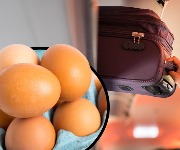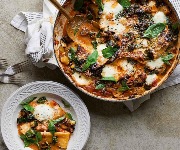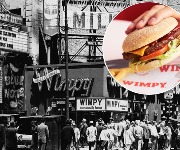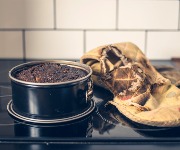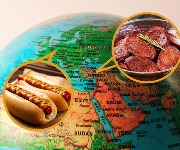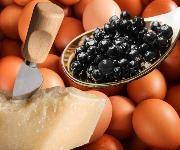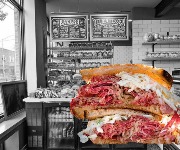How to cook a Royal wedding banquet
Wondering how to cook a wedding banquet fit for a King and Queen? Mickael Weiss, Head Chef at Coq d'Argent, has the answers...
In recent weeks, speculation about the menu for Kate and Wills’ royal wedding has reached boiling point. Whether it’s their unconventional choice of wedding cake or rumours about old Windsor favourites making a re-appearance, I’m starting to feel as if I’ve already eaten the meal myself. Twice.
However, a quick chat with Mickael Weiss proved a good remedy for such indigestion. The masterchef behind London landmark Coq d’Argent was charged with the task of recreating many of the dishes enjoyed as part of royal wedding feasts through the ages, for the upcoming BBC special ‘Giles and Sue’s Royal Wedding’ (8pm, BBC2, April 27th).
Re-inventing the past
 In their guise as married royals, Giles and Sue’s re-enactment of nuptials past culminates in an eye-popping banquet, featuring such dishes as the Queen Mother’s favourite: Eggs Drumkilbo (or as Mickael put it, a “poshed-up prawn cocktail” ), and Queen Victoria’s dish of choice: cream of rice soup.
In their guise as married royals, Giles and Sue’s re-enactment of nuptials past culminates in an eye-popping banquet, featuring such dishes as the Queen Mother’s favourite: Eggs Drumkilbo (or as Mickael put it, a “poshed-up prawn cocktail” ), and Queen Victoria’s dish of choice: cream of rice soup.
“I had to take old recipes and make sense of what they mean – adapting them to the modern palette,” Mickael says.
Despite the aid of modern kitchen technology, he found many of the dishes daunting. “They were really good recipes from the past that we then had to modernise. But some of the dishes, like mock turtle soup, pig’s head and calf’s tongue, got a little bit mad.”
‘Poshed-up’ prawn cocktail
It’s surprising to hear that many of the recipes are not quite the height of culinary sophistication you’d expect from the Royal family.
For example, Mickael took the “not very sophisticated” 1970s dinner party-esque recipe for Eggs Drumkilbo – a concoction of prawns, eggs, tomatoes and mayonnaise – and revamped it with a ketchup jelly and quail eggs. The end result? “It was ok. Very rich.”
Mickael stresses that preparing the banquet was a world away from his typical cooking technique. “I worked for anything from a week to a month going through the recipes, making adjustments. I usually work with a team of 20 but there were only 2 of us involved.” The secret to success? “We just had to do it until we got it right. Even the worst ones.”
Anyone for seconds?
And Mickael doesn’t disguise his disdain for some of the more, um, inedible menu staples. “Sturgeon royale was terrible. It tastes mucky, like it’s been washed up in an estuary. Even in the original recipes they masked the actual taste with lots of mustard and vinegar and garnishes. They even put langoustines and anchovies with it: anything but actual sturgeon!”
 The mock turtle soup makeover didn’t exactly have people calling for seconds either. Mickael concocted a mock turtle egg, made with parsnips and saffron and filled with chopped crab and winkles, and coated it with a layer of butter and breadcrumbs, “so it looked like it’d been rolled in the sand”. To complete its sea-fresh look, he also whipped up oyster water and egg whites in an imitation sea foam.
The mock turtle soup makeover didn’t exactly have people calling for seconds either. Mickael concocted a mock turtle egg, made with parsnips and saffron and filled with chopped crab and winkles, and coated it with a layer of butter and breadcrumbs, “so it looked like it’d been rolled in the sand”. To complete its sea-fresh look, he also whipped up oyster water and egg whites in an imitation sea foam.
But it looks like it may be a dish left off Kate and Wills’ menu. “It tasted good, but it looked like a dead quail’s egg. Most people couldn’t bring themselves to eat it: it’s very crunchy and chewy.”
Old vs. new
Sue’s response to dessert, however, was a different story. “I made a huge basketball-sized scoop of nougatine. Sue loved it!” Commemorative jellies have also proved a sweet-toothed favourite for newlywed royals. Edward the Prince of Wales and Princess Alexandra of Denmark in 1863 had one made using special moulds in the shape of the Danish flag and the Prince’s garter star.
These royal puddings are a far cry from Kate and Wills’ own tradition-breaking choice of two cakes: a McVitie’s chocolate biscuit cake and a more traditional multi-tiered fruit wedding cake.
Work of art
 Yet despite food’s changing fashions, Mickael was keen to stress that history hasn’t left all of the former royals’ favourite dishes behind. The cream of rice soup, served at Queen Victoria’s wedding, is very similar to a French poule au pot: “It’s basically a chicken or guinea fowl soup, with rice, cream and butter. A great dish for winter.”
Yet despite food’s changing fashions, Mickael was keen to stress that history hasn’t left all of the former royals’ favourite dishes behind. The cream of rice soup, served at Queen Victoria’s wedding, is very similar to a French poule au pot: “It’s basically a chicken or guinea fowl soup, with rice, cream and butter. A great dish for winter.”
Mickael had also cooked some of the more lavish dishes before, such as a ‘swan’ stuffed with goose, duck, pheasant, pigeon and quail: a dish fit for a king.
An updated version of a braised partridge dish served at the Queen and Prince Philip’s wedding breakfast in 1947, it was something of a work of art – a million miles from the original ‘austerity’ recipe.
“I had an artist make me a life-size swan shape on top of a glass pane – really beautiful – and then I worked to an old-fashioned recipe, de-boning all the fowl and stuffing them until it was a huge bird-in-a-bird-in-a-bird”.
The end result? “It’s roasted in the oven for three hours and comes out glistening with fat. Beautiful. It was one of my favourite dishes.”
Secret to success
 After a decade at the helm of the Coq d’Argent, what is the secret to such success – and longevity – in the high-pressure world of cooking? “Passion and hard work. So many young people want to become famous, not chefs. You have to have total commitment and take nothing for granted.”
After a decade at the helm of the Coq d’Argent, what is the secret to such success – and longevity – in the high-pressure world of cooking? “Passion and hard work. So many young people want to become famous, not chefs. You have to have total commitment and take nothing for granted.”
Finally, would he recommend any of the dishes he cooked to Kate and Wills? “None of them!” he laughs. “They should just have whatever they want. It’s their big day, after all.”
Also worth your attention:
Most Recent
Comments
Be the first to comment
Do you want to comment on this article? You need to be signed in for this feature
